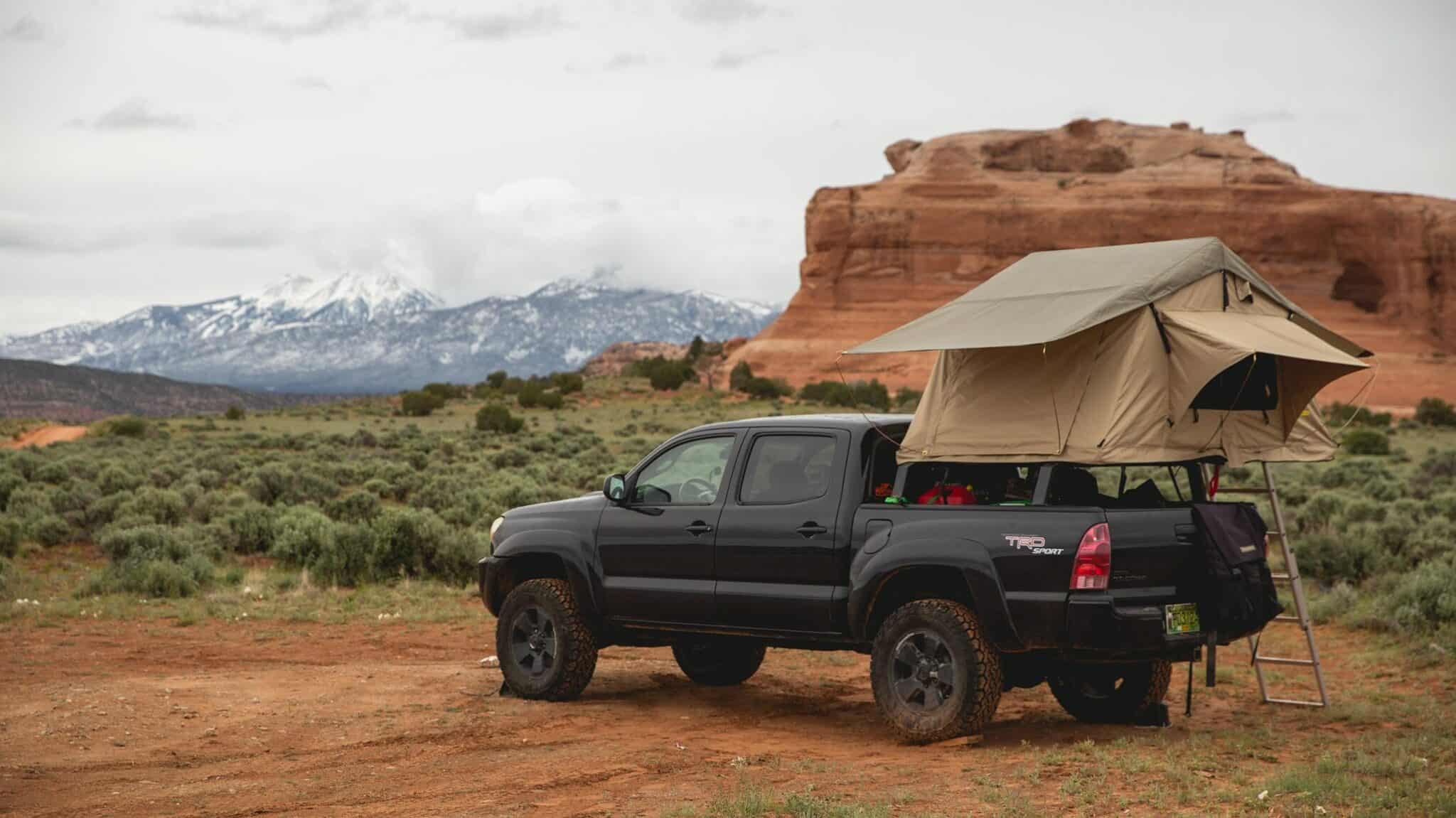
Deciding whether to use a rooftop tent (RTT) or a classic ground tent can also play a large role in how your weekend plays out. For most people getting out off-roading or backcountry camping is mainly a weekend activity. Maximizing time spent relaxing at camp vs setting up camp is the key to a quality weekend.
In general rooftop tents are more convenient when it comes to road trips or staying at camp for multiple days. A ground tent is typically better when it comes to the convenience of having a base camp that you can keep set up while you go exploring for the day.
While both rooftop tents and ground tents have their pros and cons, I believe that for most people who are serious about the camping side of off-roading, a rooftop tent is the right decision. However, if you are looking to set up camp and either do day trips, or even multiple little adventures throughout the day, then a ground tent is the best call. Continue to read on as I go more in-depth about the pros and cons of each setup and help you decide which is most convenient for you.
Rooftop Tents vs Ground Tents: Pros and Cons
As I mentioned above they both have their very strong pros, as well as their hard-to-argue cons. While this might muddy the water when it comes to trying to decide which is the right choice for you, hopefully, my lists below will help. I recommend really focussing on your needs. It is easy to get caught up in the glam and look of having an RTT on your vehicle. It doesn’t matter how cool you look at camp, if it’s not practical for you, it’ll become more of a hassle than an enjoyment.
Rooftop Tent Pros:
- Quick setup
- Minimal space needed
- Comfortable without add-ons (such as a mattress)
- Some have power built into them. (Redtail Skyloft)
- Potentially safer from predators such as bears
- Can be insulated for warmth during cold season camping
- Keep you elevated above wet ground
- Can be leveled on a sloped surface
Ground Tent Pros:
- Inexpensive starting price
- Lightweight
- Can be used as a basecamp after the initial setup
- Potential for large living space or multiple rooms
- Can be used for multiple variations of camping. (boat camping, off-roading, horseback camping, hiking, etc)
- Easy to set a tarp over the top of
- Smaller footprint at camp
- Can be hung to dry if it gets wet
Rooftop Tent Cons:
- Expensive (Range from $1,000 – $6,000+)
- The average weight is around 100lbs
- Can cause wind drag depending on where it is mounted
- Can be difficult to set a tarp overtop of
- Large footprint due to your vehicle
- Must be closed to move your vehicle
- Need substantial space to open it to dry
- Must use a ladder to get in and out
- Needs to have a rack to mount it to
Ground Tent Cons:
- Longer set-up time
- Must be conscious of groundwater flow to avoid a wet sleep
- Thinner material that is more prone to rips
- No built-in mattress
- Need a level surface to set up on
- Additional footprint to your vehicle
Is A Rooftop Tent Worth It?
Rooftop tents are everywhere in the 4-wheel drive world now. From rock crawlers to massive overland rigs, and everything in-between. They have taken the North American offroad scene by storm. While they have been around since 1958 (originally invented in Italy), their popularity has exploded in the last 8 years with the rise in popularity of Overlanding. Seems that every Tacoma, 4Runner, and Jeep Gladiator in my area has an RTT mounted onto it now… mine included!
While they can change your camping experience to a glamping experience, they can also be a massive inconvenience. Before we go through the cons list though, let’s focus on the pros I had listed above.
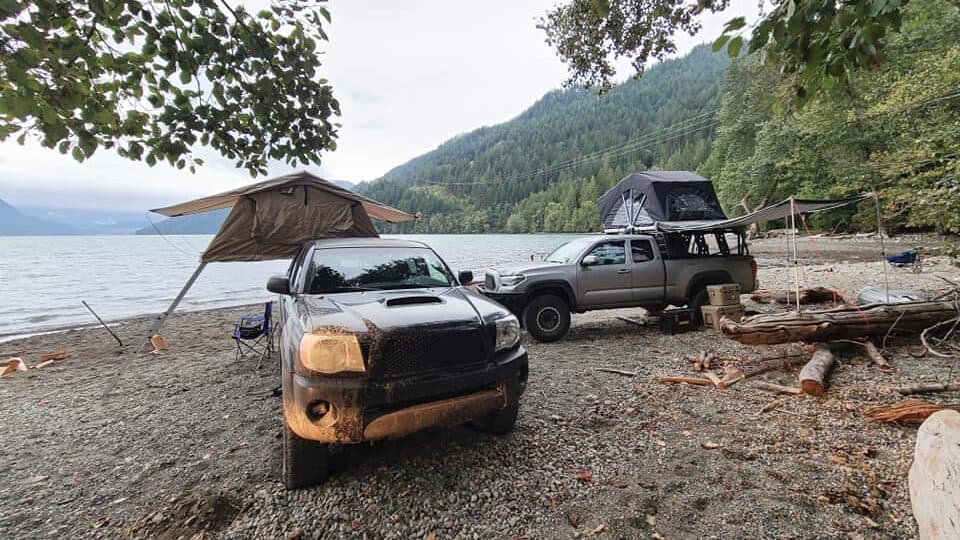
– Quick Setup:
Once upon a time I had a ground tent that I could set up in under 30 seconds. I just had to take it out of its bag, throw it in the air, and KA-POW, it’d spring open. It was awesome, except for the couple times I through it up and didn’t take the wind into consideration and was suddenly chasing my tent as it blew away. Once the tent was set up though, I still had to blow up my air mattress and sleeping bag. With my RTT now, I leave all my bedding in it, minus my pillows.
I have a softshell Smittybilt RTT, one of the cheapest ones on the market, and my set up time is about 2 minutes. Once my vehicle is level, all I have to do is flip it open, put the two rods in for the fly if I have it on, and throw my pillows in. Easy-peasy.
Because my tent is a softshell, it is a slower process to set up vs a hardshell RTT. My friend’s harshell takes under 30 seconds to set up if you have 2 people. There are 4 clasps you undo and the tent opens straight up. The disadvantage to their tent is, they cannot store their sleeping gear in it.
– Minimal Space Needed:
This is a bit of a true and false-statement. A rooftop tent only needs about as much space as the vehicle takes up. This is especially true with a hardshell tent, as they either open straight up or like a clamshell. My softshell tent doubles its footprint when open. Which means it sticks off my truck by about 3.5 feet.
This makes it extremely convenient when on a road trip. As you don’t need to find an additional spot for your tent when you pull into a location. As long as your vehicle fits, you can sleep there.
– Comfortable Without Add-Ons:
Rooftop tents come with mattresses built in. This means a quicker setup time, and no more refilling your air mattress at 3 in the morning.
– Power Built-In:
Having power built into your RTT is a true luxury with a luxury price tag attached to it. This is far from common in the RTT world, but it does exist. The Redtail Skyloft for example has exterior solar panels which then power the USB outlets and light inside the tent. They even have fans built in to keep airflow in your tent and keep things cooler during those hot summer nights.
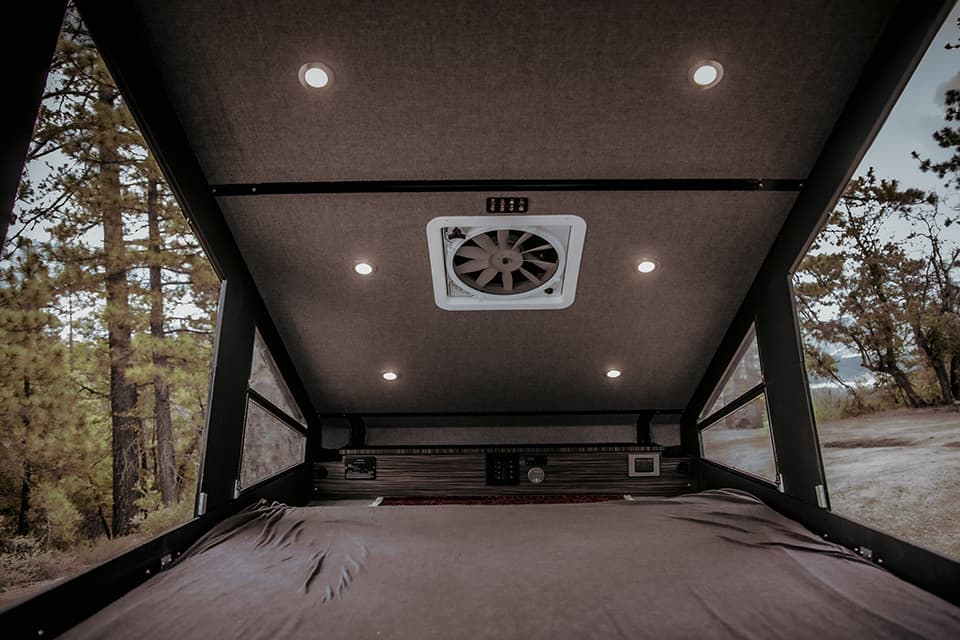
– Potentially Safer From Predators:
While this may sound like a stretch, and may very well be, I much rather hear a bear sniffing around at night when I am 7 feet off the ground vs laying on the ground. Let’s be real though, if a Grizzly wants you, a Grizzly will have you. Whether you choose an RTT or a ground tent, remember to practice regular bear awareness. Keep your food in sealed containers, a good distance from camp, and up a tree when possible.
– Some Are Insulated:
This is not the case for all rooftop tents, but there are a number on the market that have insulated mats for winter camping. The insulation helps keep your body heat in and the cold winter air out. This also means there will be less moisture build up on the inside of the tent when you wake up in the morning.

– Keeps You Elevated Off Wet Ground and Keeps You Level:
The last two points I will combine, as they go hand in hand. Because the tent is mounted either to the bed of a truck, the roof of an SUV, or maybe even on a utility trailer, it is easy to level. Simply stack wood, rocks, or traction boards to level yourself out. Being off the ground also means that no matter how hard it rains at night, you won’t wake up to a wet bum!
Now that we have covered the pros of a rooftop tent more in-depth, let’s go over the cons. Keeping in mind that these are based on my experience.
– just Expensive:
Unless you are purchasing a used rooftop tent, which is a completely legit option, you are looking at spending at least $1,000. Compare that to a ground tent which you can purchase for $50 from a big box store.
They start around $1,000 but climb to over $6,000 depending on the brand and what sort of accessories you have. You better be doing a lot of camping or Overlanding to make that $6,000 worth it! Keep in mind the average price hovers around $2,000.
I recommend keeping an eye out for sales at your local offroad shop. Everyone seems to have mixed opinions about 4 Wheel Parts, but I got my tent for $1,050 on sale, with a 3-year no-fault warranty. Can’t beat that!
– Heavy and Causes Drag:
On average, RTTs way around 100 pounds. A hundred pounds isn’t all that much extra weight when you consider it weighs less than your average passenger, however extra weight is extra weight. If you are adding armor to your vehicle, bumpers, sliders, skid plates, etc, things add up quickly. The tent’s extra poundage could bring you over your vehicle’s max load capacity when you’re packed to hit the road.
The weight is one thing to consider, but I would say the drag that an RTT creates is a larger deal breaker for me. Companies in the past few years have done an excellent job of slimming down their tents. You are still mounting a rectangle on the back or top of a vehicle though. Your fuel economy will be affected.
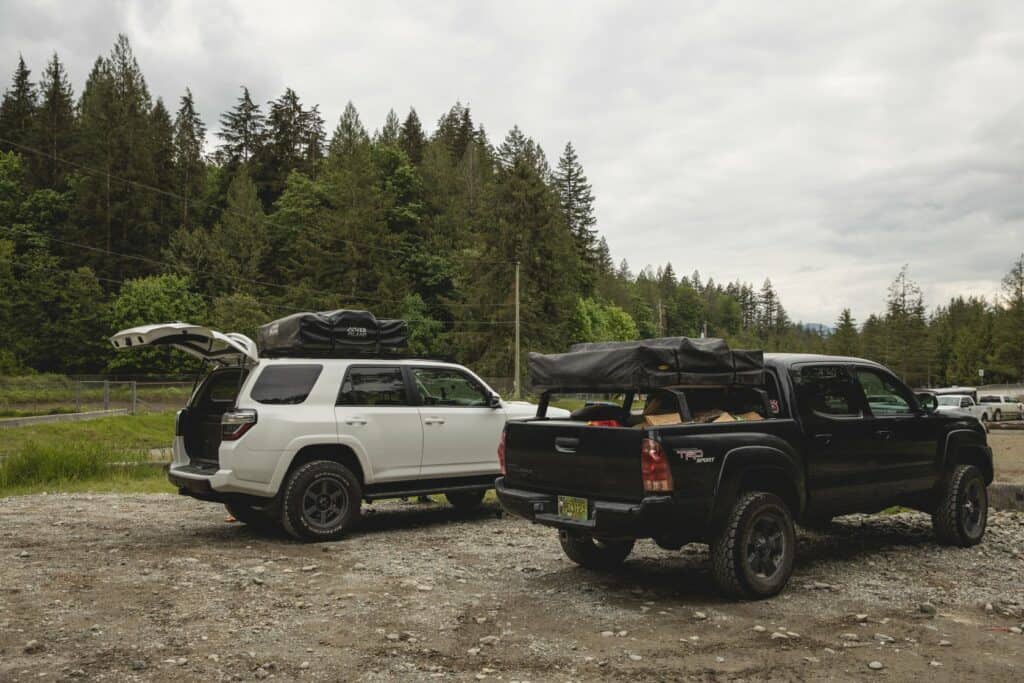
– Makes Setting Up A Tarp More Difficult:
Setting up a tarp is challenging at the best of times, now add an extra 4 feet of height on top of your vehicle. You have to find some high branches!

– Large Footprint Due To Your Vehicle:
I know that I mentioned in the pros that a rooftop tent means that there is limited space needed, but I also said that it’s both a true and a false statement. This means, you only need a spot large enough to fit your vehicle, but you need a spot to park your vehicle. A ground tent allows you to park in one spot, and camp in another.
On a road trip, my friend and I did to California we were struggling to find a place to camp. It was late at night and we were in an area that didn’t provide much opportunity to drive off the pavement. We found a spot on the road where we could pull over and set our ground tent up in the sand dunes along the ocean and out of sight from the road.
If we had only had a rooftop tent with us, we would have been sleeping in the open on the side of an industrial road.
– Must Be Closed To Move:
Out of any of the downsides to a rooftop tent, this is by far the one that causes me the most annoyance. It’s also the one I have heard about from the most people.
Let’s say you are headed to Moab, and you’ve locked in a campsite for 4 nights, and you plan on wheeling and exploring every day. Having a rooftop tent means that every morning you have to pack your tent up before you head out, and every evening you have to set it back up. And God forbid that you decide to go for a night run at the last minute and you have to pack everything up yet again.
Now keep in mind, if you are on a multi-night road trip my opinion is that opening and closing a rooftop tent is more convenient than a ground tent.
The downside comes into play when you have a base camp for a couple of days and you could just leave a ground tent set up for the whole period of your stay.

– Needs Substantial Space To Dry:
Just like a regular tent, if a rooftop tent gets wet you need to let it dry before closing it up for an extended period of time. With a regular tent, you can simply hang it over a chair or two on your patio or in your basement, but with a rooftop tent, you either need to wait for a sunny day or have a covered area that is high enough for the tent to open. Of course there is always the option of taking the tent off the vehicle, but that would be quite the hassle if you camped often.
– Must Use a Ladder To Get In And Out:
This might be seen as a null factor for some people and for others it’s a big deal. Personally, the ladder isn’t a big deal for me. However, if you have to get up in the middle of the night to use the facilities, the ladder can feel like a bit of a death-defying stunt. If you camp with an animal, the ladder may prove to be an inconvenience for you as well if you’d like to have said animal in the tent with you.
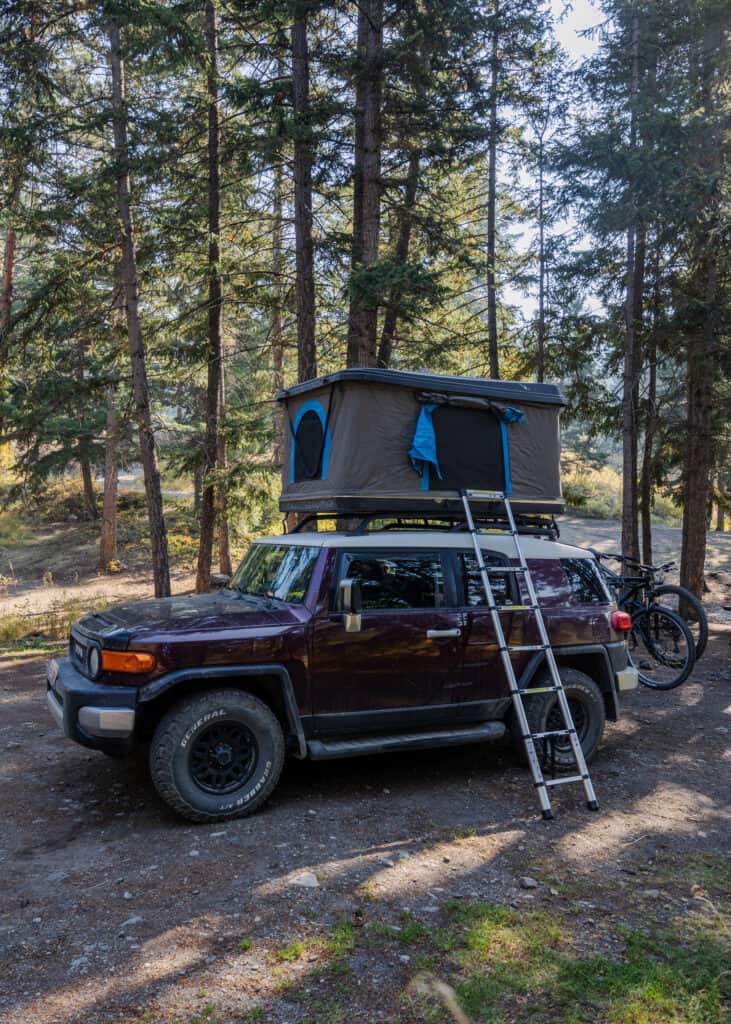
– Must Be Mounted To A Rack:
In some ways, this is a convenience, as your rack can serve as a mounting point for other equipment such as shovels or jerry cans. However, a rack is an additional expense on top of the tent’s original price. I had a friend weld me a rack and it cost me about $300 and a case of beer.
If you are purchasing a name-brand rack, expect to be paying around the $1,000 mark.
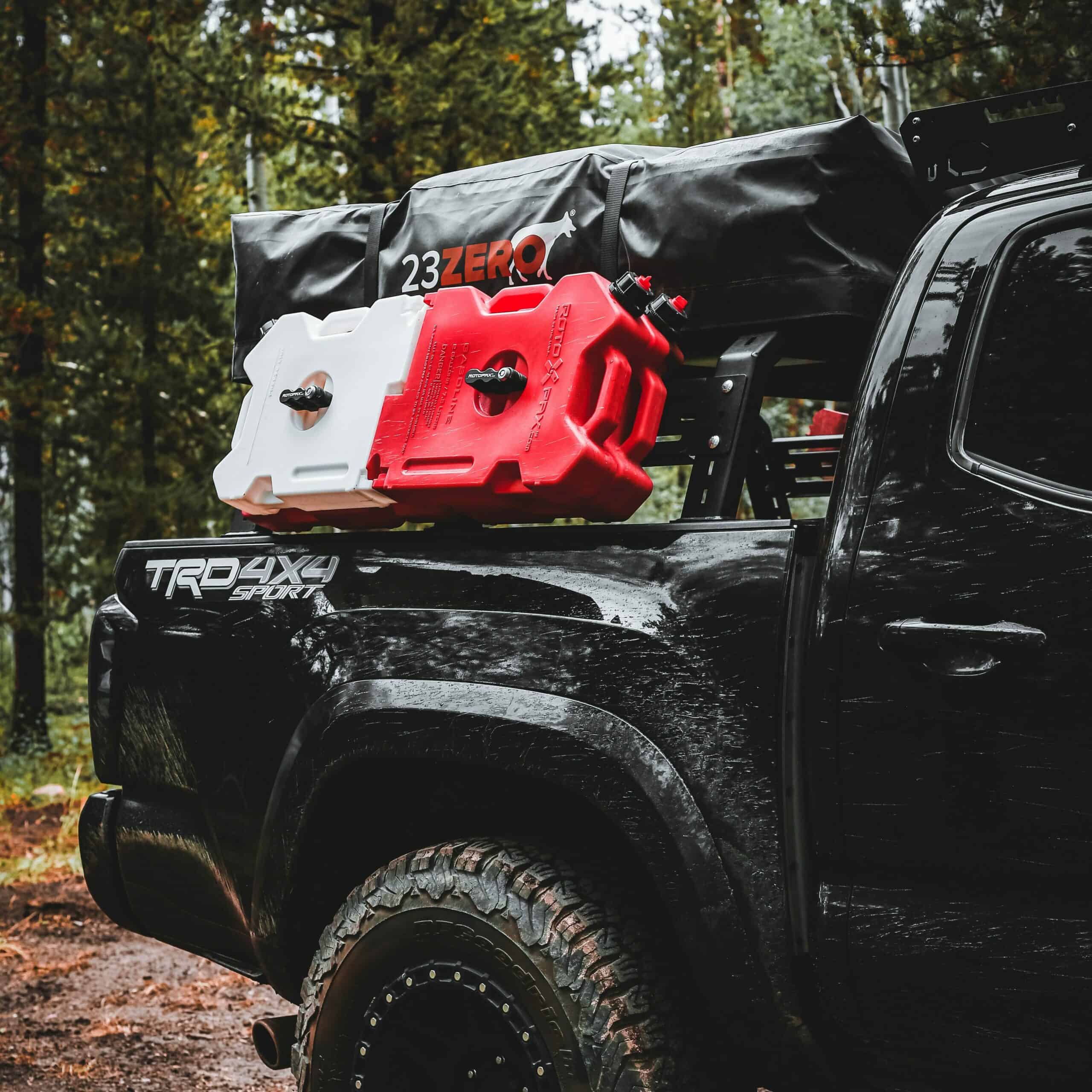
Is Using A Ground Tent Recommended?
We have covered the pros and cons of a rooftop tent, now let’s go over the perks and drawbacks of camping with a ground tent. Starting with the perks.
– Entry Level Pricing:
As I mentioned previously in the article, you are able to find a ground tent for around $50. With the [minimum] $950 you saved from not buying an RTT, you could then purchase suspension, tires, armor, lockers, or a number of other things that will make your 4×4 more capable.
– Lightweight:
You can easily find a 4-person tent that weighs around 10 pounds from any big box or sporting goods store. Even a 10-person tent can weigh less than 50 lbs!
– Can Be Used As A Basecamp:
Unlike a rooftop tent that you have to pack up before you head anywhere, a ground tent you can leave set up if you head out on a day trip. I don’t like leaving my stove and bbq behind when I head out for the day, so having a ground tent would also mean you could keep your spot “reserved.”
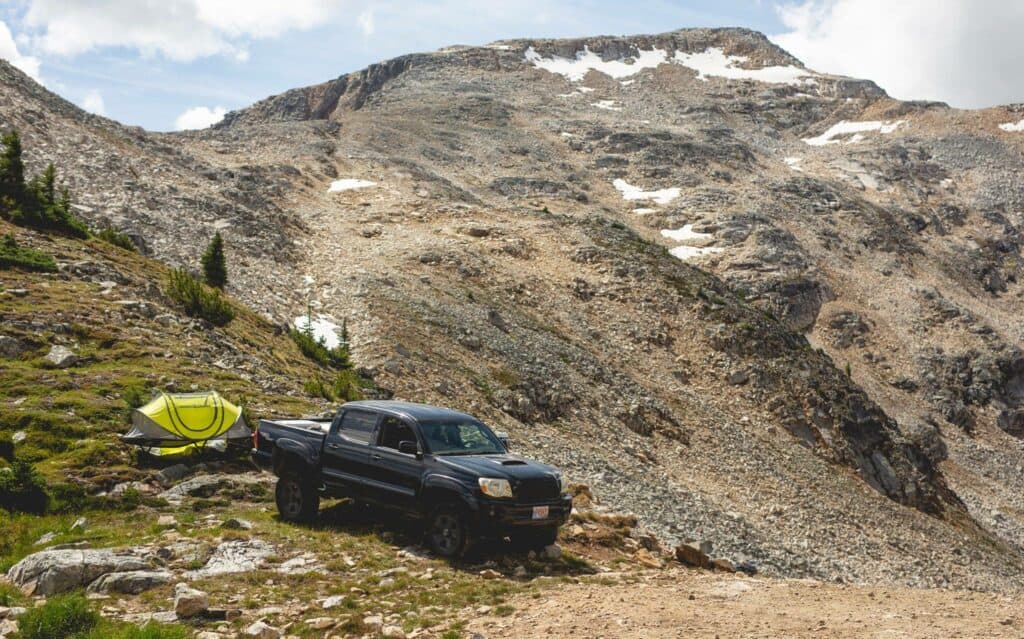
– Potential For Large Living Space and Multiple Rooms:
To my note, about 10-person tents that weigh under 50 pounds – 10-person tents might seem excessive, but they would allow you to truly camp in comfort no matter the weather. Many of them have dividers to split off rooms. You could have one side of the tent as your sleeping area with a large air mattress, and the other could be your eating area if there are lots of bugs you need to seek shelter from or the weather is nasty. You could also set up a diesel heater so you’d have clean and dry air keeping you warm if the temperatures drop.
Another perk to the dividable spaces is one for families. No need to camp with multiple tents for yourself and the kids. Simply set up one tent that can house the whole clan!
– Various Versions of Camping Open Up:
Having an RTT means you are camping with your vehicle. That’s it. Having a ground tent allows you to do various types of camping that aren’t limited by your vehicle. The primary camping I do is with my vehicle, so I have a rooftop tent. However, I also have a 1 person ground tent that I take hiking and bikepacking.
I also know people that boat camp. They’ll throw all their gear in a boat and find a remote beach to spend a few days on. That is something you can’t do with an RTT.
– Easy to Tarp:
Most tents are under 6 ft tall, which means your tarp can be substantially lower than a tarp overtop of a rooftop tent. There is always the option of just tarping the RTT, but I like to have my whole site tarped off with a 20×28 foot tarp. Getting that thing 15+ feet up in the air can be quite the task. Only needing it 7 or 8 feet off the ground would be much simpler.
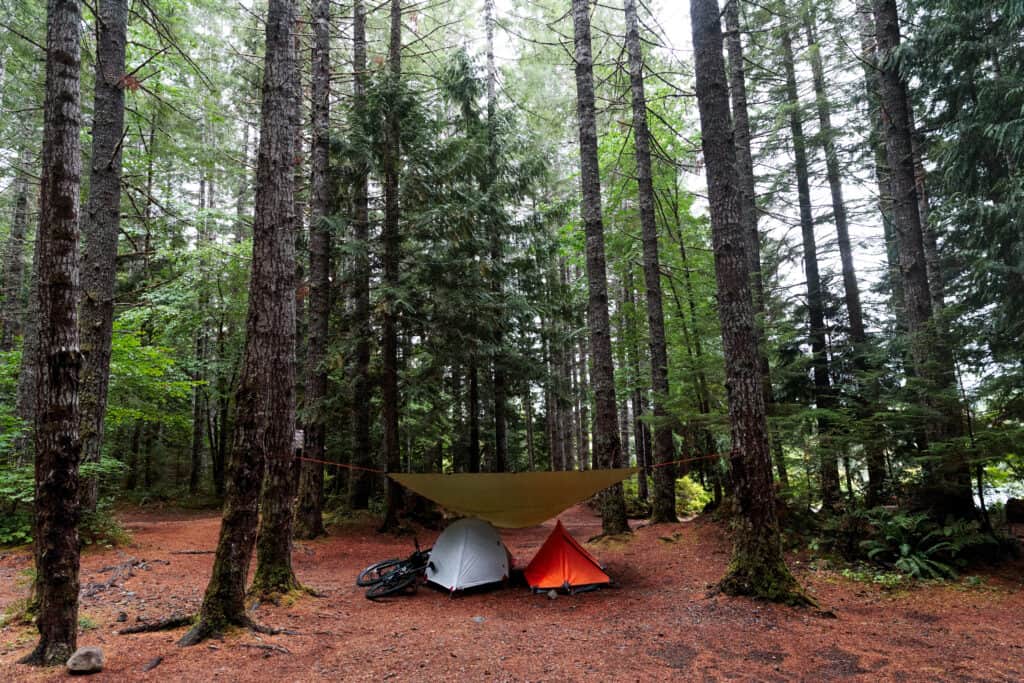
– Small Foot Print:
I won’t repeat the California story, but it rings true to this. Also, there are times when you are off-roading when you will find the perfect spot to camp, but maybe your vehicle is just a little bit too big. Having a ground tent to throw down could be the difference between getting a good night’s sleep and searching late into the night for a place to set up.
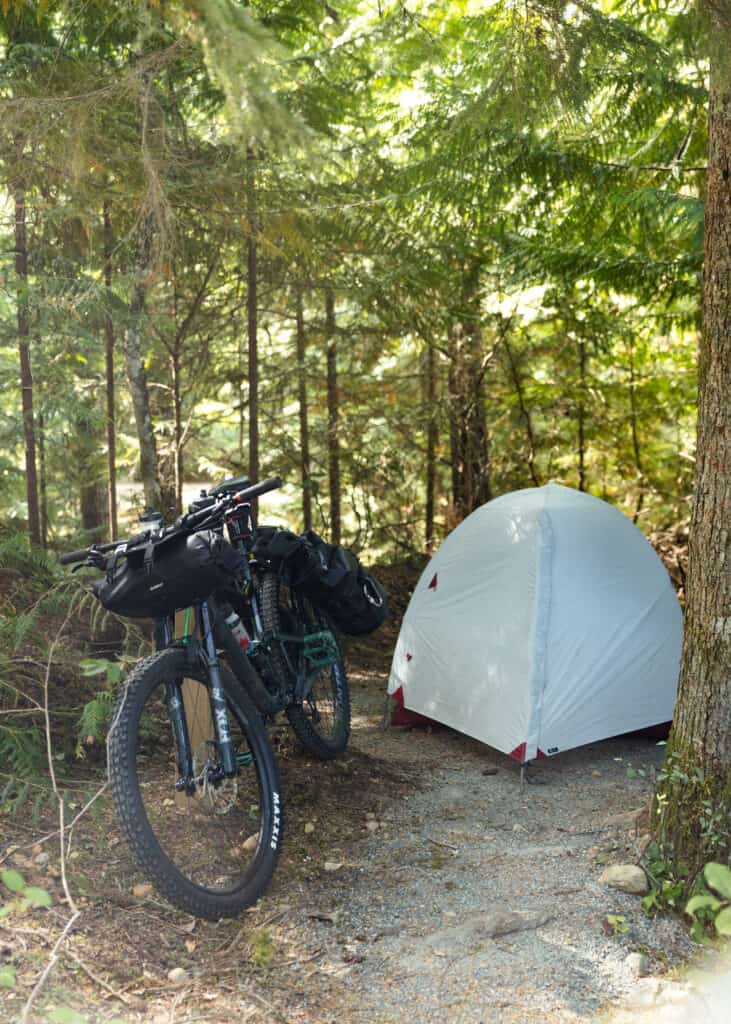
– Can Hang To Dry:
Getting wet camping sucks. What’s worse though – setting up your tent and finding mold inside because it wasn’t dried out properly. Having a simple ground tent means that you can hang it up to dry using minimal space. Compared to having to find a large covered area or a sunny day to dry out your RTT.
Those are the pros of owning and using a ground tent to camp. Let’s go over the drawbacks now of using a ground tent.
– Longer Set-Up Time:
Picture this, you have been driving for 8 hours straight or maybe been stuck on a track all day and you’ve finally rolled into camp at 11 pm. The last thing you want to do is set up a tent. With a rooftop tent, you simply flip it open and hop in. For some RTTs like mine, you are even able to leave your sleeping bags inside of it when it’s folded up. All you have to do at camp is throw your pillows in.
With a ground tent though, you have to find a level spot and then go through the motions of setting it up. Not to mention, setting up a regular tent is often a 2 person job. Better hope your partner isn’t cranky!
– Must Be Conscious of Groundwater:
There is nothing like the feeling of waking up damp. I’m willing to bet that anyone who grew up camping in the PNW knows what I am talking about. If you don’t set up a tarp on the ground, the moisture from the ground can come through the base of the tent.
Worse yet, it rains while you are sleeping and you are set up at the bottom of a slope. All that water will gladly introduce itself to your tent.
– Thinner Material:
This is both a pro and a con. Thinner material means it’s lighter. However, in most cases, it means that it’s not nearly as durable as the thick canvas of an RTT, and could be prone to tears.
– No Built-in Mattress:
Not having a mattress built-in means that you have added an additional item to the packing list as well as an extra step when it comes to setting up camp. Oh, and God forbid you have a leaky air mattress. There is nothing quite like falling asleep in pure bliss and then waking up at 3am to a rock jabbing you in the back because your mattress has deflated.
On the flip side, if you don’t mind the extra item to pack and the extra step at camp, you could technically bring a queen or even a king-sized air mattress with you. Do I think that’s a little excessive? Absolutely! Am I ever jealous of those folks? 100%!
– You Need Level Surface To Set Up:
With a rooftop tent mounted on a vehicle or trailer, you can easily level the platform out using rocks or boards. With a ground tent though, you need to find level ground or grab a shovel and make some. You also have to be on the lookout for rocks or pointy roots. Those two things can both make your sleep uncomfortable from jabbing you, and could potentially poke a hole in your mattress.
– Additional Footprint To Your Vehicle:
This is my third time mentioning “footprint” in this article, but I believe it is a large factor when it comes to convenience. We’ve discussed the fact that a ground tent allows you to camp in small spaces without your vehicle. And we’ve touched on rooftop tents being extremely convenient when it comes to being able to quickly set up in a space that just fits your vehicle.
Most of the time camping though we aren’t in either of those situations. We have an area that is around 20 feet by 20 feet, and our vehicle has to be parked there in some sort of configuration. Having to set up a ground tent then takes up even more space that could be used for cooking or camp activities. Again though, this is one of those points that I think it’s fairly easy to argue both the pros and cons of.
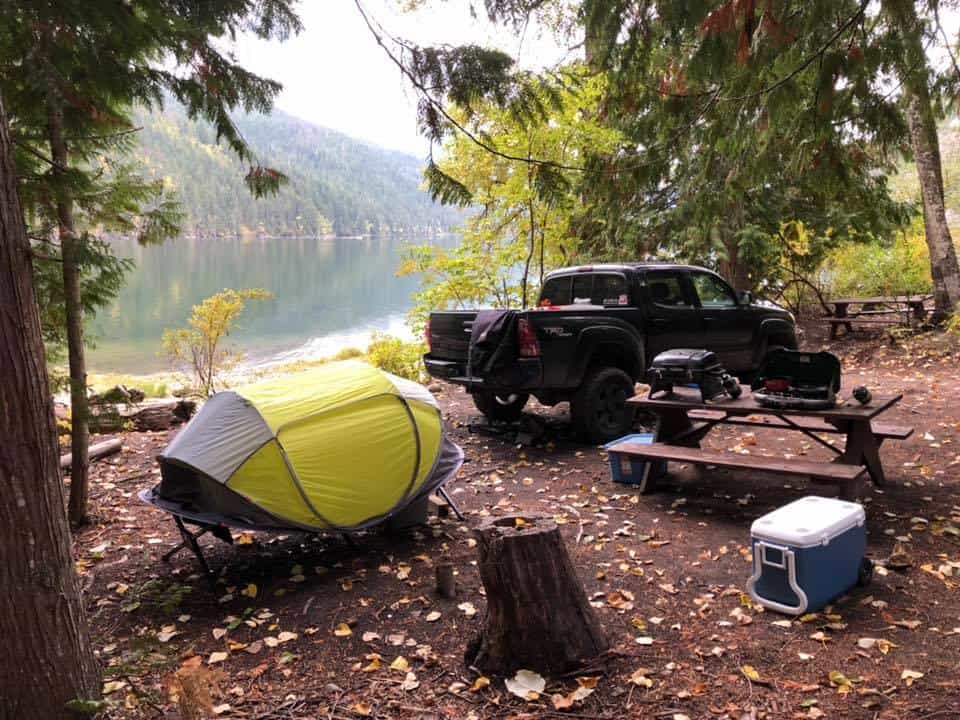
Final Verdict: Should You Use a Rooftop or Ground Tent?
My advice to you before purchasing an RTT is to start with a ground tent. Dial in your camping setup and when you feel you’ve outgrown the tent, or it has become too inconvenient, then spend the money on an RTT. This will also allow you to really figure out what style of rooftop tent you want and need. On the other hand, maybe you’ll realize a ground tent is more than enough for you!
I am a big supporter of starting with the basics and upgrading as needed. Rather than spending thousands of dollars upfront and realizing you have more than you really need.